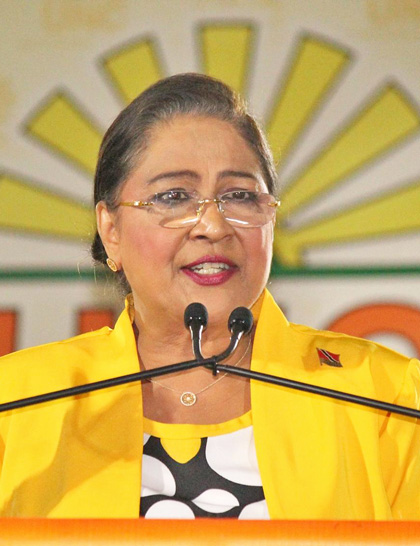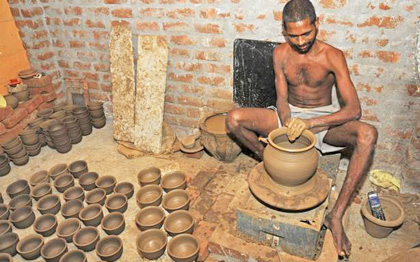Trinidad & Tobago
Persad-Bissessar:
Nation needs leadership

Port-of-Spain – Trinidad and Tobago needs leadership, Opposition Leader Kamla Persad-Bissessar said last Friday at the Ladies Night of the National Council of Indian Culture's Diwali Nagar in Chaguanas.
Persad-Bissessar said even as the country prepares to observe the Hindu festival of lights, there is much darkness in the country.
“Today, our country is at a crossroads. While the 'light' of the recent outpouring of love in a time of disaster is welcome, it is overshadowed by darkness – the scourge of crime, joblessness leading to hopelessness, an ailing economy – there is no doubt that action is required to dispel this darkness,” she said.
Persad-Bissessar added: “We have seen, in the last few years, the growing need for vision, and leadership, to take us out of this predicament, and move us forward into a brighter, more prosperous future. We need caring, compassionate leaders who are willing to listen and engage with citizens. We must reject attempts at division, oppression, deceit and trends towards autocratic leadership. Our leaders must be held accountable and be called upon to place their own needs aside and have the strength, the will and the vision to do what is right, and what is necessary for the good of the country.”
But despite the dark times, Persad Bissessar said there is always hope. And she urged the public to join in the efforts to build a better nation.
“Let us work together, stand united, and ensure that our country rises to meet the challenges we face and not only thrive, but prosper. As we celebrate Diwali let each of us pledge to stand against everything that puts our mothers, sisters, daughters and indeed, all our citizens at risk. Let us pledge to work to bring the light of Mother Lakshmi to those who are handicapped by darkness, poverty, alienation, abuse and exploitation. Let us pledge to ensure that our society respects women's right to equality through education and opportunity so all females can take their special places in society as leaders who are blessed with the strong elements to nurture and build with love and compassion.”
Persad-Bissessar also stressed the importance of women in society.
“Look around our world today and you would see women successfully guiding nations as prime ministers and presidents – right here in Trinidad and Tobago we welcomed our first female President,” she said.
“Women are also staking their claim as professionals, businesswomen, CEOs, entrepreneurs and advocates for various causes. Yet not too long ago the traditional role for women was to be subservient to our male counterparts,” she added.
But despite the progress made towards gender equality, Persad-Bissessar said some societies reject the idea and continue to refuse to accept the importance of women.
“It is, therefore, our duty to respect and recognise women for the valuable role we have in the daily lives of our society in the same way that we recognise the divinity of women. Whether it is in spirituality or civil society, women have been central pillars in the construction of our various societies,” she said.
The floods started on October 19, and left thousands of families in distress. The nation’s Prime Minister, Keith Rowley, described the aftermath as a national disaster.
Thousands of nationals suffered tremendous losses in damage to houses, household effects, and appliances. Many Hindu devotees among the victims have since indicated they are either unable to celebrate the Festival of Lights, or are scaling back on the festivities.
It is going to be a dark Diwali for many this year.
Residents in one of the badly affected communities, St Helena, known for its stunning Diwali displays, decided to scale back on lighting up this year. The only reason they are going ahead with any celebration at all is for the sake of their children.
“It started off looking like a dark Diwali and for many; it will be,” said Cindy Sankar, who lost most of her household items.
“I think a lot of people will try to bring some light in for the season, at least for the sake of the children,” she said.
Sankar said many families remain displaced and dependent on others for the use of appliances such as stoves and refrigerators. Many people are still unable to cook, and store food, and this will impact on their Diwali preparations.
Other residents were not as optimistic as Sankar, with one family making the decision to leave the area after decades of floods.
“I can't even call this a dark Diwali. I think Trinidad is just seeing dark times,” one frustrated and despondent mother said. Her three children continue to suffer following the October floods.
“There are people in this area who have to replace items in their homes nearly every year, and it is getting worse,” she said.
She noted while there has been a lot of aid for the affected families, some living in the area are unable to return to their houses due to extensive damage.
“Right now, most people are concerned with just getting through each day as it comes, because you have to be asking people to keep things for you, to use their stove, their washing machine. I think most of us are just grateful for life and will probably just light a deya for that,” she said.
In south Trinidad at Debe Trace, Gangadie Gangapersad said she typically celebrates the Festival of Lights with close to 250 deyas. However, she will only light 36 deyas this year.
Gangapersad’s daughter Reshma Bachan was making plans to just light up the porch of their house, with no lights on the outside. She remains fearful that either the rains, or floods, may come again like last year and put out their Diwali celebrations.
“We are also cooking our own roti this year, because last year we had to wade through floods to get the roti we ordered,” Bachan said.
Bachan said the October floods left many areas in ruins. The mood since has been that Diwali 2018 could become one of the most depressing celebrations in recent times.
Basso Singh, of North Oropouche, said Diwali was not shaping up to be a happy celebration for her family, and for her many neighbours who continue to suffer from the October flood.
“We have tried to clean up as best as we could. Flood water could have covered me below our house. We had to throw away our fridge, wardrobe, stove, and couch,” she said.
At Harripaul Village, Picton, widow Deokie Mahabir and her children also predicted a dismal Diwali following her house being flooded yet again this year.
At Gopie Trace, Penal, residents said there will be no traditional street light up this year. Usually, lanterns are strung across both sides of the streets and prasad is distributed to motorists who visit to enjoy the lights.
Meanwhile, while thousands of resident suffer from the flooding fallout, devotees who are celebrating Diwali are encountering increased prices for vegetables that make up the traditional festive meals.
As the floods went down, it appears food prices have gone up.
While there is a customary spike in the prices of fresh vegetables based on Diwali demand, it appears that last month’s deluge has led to an exponential increase in prices. Diwali dinners are now costing more as food crops in the Aranjuez basin, and harvests in East and South Trinidad, are reportedly mostly destroyed.
Over the weekend at the Tunapuna Market on Eastern Main Road prices were higher compared to three weeks before. Pumpkin was being sold at (TT) $6 a pound, up from $2. Spinach, which was $8 a bundle at the start of October, was $10; tomatoes which were $9 a pound before the floods were being sold for $18 to $20.
Three weeks ago, six bundles of celery cost $10, but over the weekend had gone up to $24.

Master potter, Andy Benny, working out of Edinburgh, Chaguanas in central Trinidad, hopes the light may not be going out in what he describes as a dying artform. Last week he was lighting up the oven in Edinburgh, central Trinidad, to fire the last batches of handmade, clay deyas, the final burn totalling over ten thousand, the artisan lifting the small clay pots gently off the drying racks, carefully holding each vessel snugly like hatchlings in his cupped palms.
The firing oven is a solid, practical affair, a concrete-cast trough, around five feet wide by 15 feet in length, a depth of about four feet; it is reinforced at five-foot intervals across its width with the thick, solid columns of railway track, the rusted iron repurposed from a now-defunct railway system, an echo of an age and time when yet another flame burned low and its lights went out.
After firing up the wood-burning oven, Benny stands at its brink, gazing contemplatively into the flames consuming the found detritus of fuel – mainly discarded wooden pallets, assessing the rising heat for readiness. Like a master baker, he uses both palms encrusted not with clinging, kneaded flour, but coated to the elbows with wet yellow clay, positioning each hand downwards to assess the steadily rising heat.
By then, Benny was in the final phase of production, having fired up close to 200,000 diyas in the lead-up to Diwali. A fourth generation potter, flames from the oven played with the shadows on a face darkened with anxiety about the future of the tiny, handmade clay pots. Adding to his worry are this year’s conservative sales, fallout from devotees scaling back on the grandeur of Diwali celebrations, their confidence and affordability impacted in the pocket by the devastating floods that hit Trinidad and Tobago last month.
Diwali 2018 has seen the business take a major financial hit, Benny says. Demand for pottery ebbed following the national disaster of widespread flooding, the market draining down with the floods.
Many Diwali celebrants were hit hard by the flooding, Benny says. What would have been income for celebrating the Festival of Lights now has been repurposed for recovery from damage to houses, household effects, and major appliances. The celebration of light has been toned down, the hit even harder now on an industry that seems to be growing more fragile with each passing year.
The unusually wet weather did not help with diya production, Benny notes. Production starts six months before the celebration, and is intensive work. It means readying the clay, handmaking the diyas, and finally, there are 20 hours of firing in the oven for each batch. Drying thousands of deyas in the unseasonal, wet weather added to turnaround time, with the record rainfall, and its moisture, extending the sitting hours for each piece of pottery.
Such uncooperative weather prove to be yet another spanner in the clay-works, Benny says, an additional burden on the traditional labour woes that haunt the business. The shortage of labour remains a major problem, he laments.
The art of making diyas, and pottery as a whole, is folding unto itself, with the profession not viewed as profitable by employees who are moving away.
Potters with the skill of hands moulded with decades of experience are finding it more and more difficult to pass down the craft to an unwilling, younger generation, and the masters are dying out with no succession, Benny laments.
“This year we lost one of our skilled masters, Deonarine Ramcharan,” Benny adds. Ramcharan died tragically after being hit by a vehicle.
Sadly, the profession is also being undermined by alcohol addiction: “Puncheon [rum] is a problem. We can only get them to work in the first half of the day. The second half they go missing,” Benny says.
There was a time when the craft was in its heyday. Recalling the good old days, Benny notes it started with the arrival of his ancestors, who brought pottery skills across the kala pani. There was his great maternal grandfather, Seecharan, and sibling, Goolcharan, who both came from India with hands already knowing how to form clay into pots. Seecharan settled in Chaguanas, while Goolcharan journeyed further south, where he started a pottery shop in Rio Claro. Since then, like their pottery, the family has shaped and reshaped their good name, with succession from father to son, or father to daughter, taking the craft across the generations. Benny’s mother, Radika, established a pottery shop, which is well-known today in central Trinidad.
For some relatives who maintain the pottery tradition, it has meant keeping up with the times and technology. As Benny notes, a few family members now run the business using automation. But for him, there is nothing as personally rewarding as lifting up a pot from a lump of clay using the fingers and palms in the traditional way.
Also, there still remains a market that is nostalgic about the old ways, a throwback that retains one of the many shapes of the past in how our ancestors dispelled the darkness of the Trinidadian landscape during Diwali.
“There are purists who want the pots created by hand,” Benny notes.
This nostalgic, less mechanised trope is recognisable in the ambiance of Benny’s workspace. In this shop, a wooden house is stacked with diyas, the cups nestled into each other and rising in towers to the rusted underside of the galvanised roof.
Nearby and handy to the potter’s wheel is a mound of the yellow, sapatay clay, the motherlode brought in by the truckloads and deposited within walking distance. Paused on tiers and sitting on planks of wood are handmade pots and vases at rest, its freshness from the wheel noticeable in the stages of wet and dry inscribed into the rounded bellies of the smooth, shaped clay.
Benny uses a pugmill to knead the clay. Before the pugmill, his ancestors danced on the wet clay, their bare feet seeking out coarse impurities.
“That was not fun. It was hard work,” Benny says.
His love for clay elevates it into the respect conferred by an artist for the medium.
“I hate when they call it mud. It is not mud. It is a special clay which we get three or four feet underground, where there are no impurities like nail, bottle, grass, or roots. I bring in six truckloads every six months because we do pottery right through the year,” Benny adds.
The kneaded clay is removed from the pugmill, put on a rolling board, and then manually rolled into a block. This is then spun on the potter’s wheel.
Like the oven, the potter’s wheel is an assortment of the found, reshaped, and refined from the landscape Benny, and his ancestors, arrived in and have now repurposed to recreate the traditions of ancestry and craft. The potter’s wheel is an assortment of old car parts, drive belts, pulleys and motors. Despite its disparate origins, the spin is even and balanced, the wet clay gently rising upwards, guided by Benny’s hands and fingers as it is lifted into a tall cone.
And then, in a textured coordination of finger and thumb, Benny presses in and down into the top point of the cone, effortlessly forming the well-known cup of the deya. With the finishing cut of a string, the newly-formed cup is lifted into its individuality out of the spinning motherlode cone of clay, the perfect edge of its newborn circumference softly pinched to nestle the wick.
In its defining moment, Benny’s hands are a blur of motion and premeditation, a confluence of movement as both director and performer, the hum of its motors rising as the potter’s wheel spins with its burden of clay and tradition.
(With files from the Trinidad Guardian)
